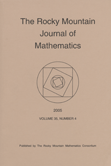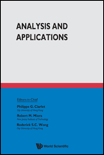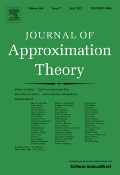
Dolomites Research Notes on Approximation
Scope & Guideline
Bridging Theory and Application in Mathematical Research
Introduction
Aims and Scopes
- Approximation Theory and Techniques:
The journal covers a wide range of topics in approximation theory, including polynomial approximation, interpolation methods, and convergence properties of various approximation operators. - Numerical Methods and Algorithms:
It emphasizes the development and analysis of numerical methods for solving mathematical problems, including integral equations, differential equations, and optimization techniques. - Special Issues and Celebratory Publications:
The journal features special issues dedicated to notable contributors in the field, showcasing their works and contributions, further enriching the academic discourse. - Applications in Various Fields:
Research published in the journal often explores applications of approximation techniques in fields such as engineering, physics, and data science, demonstrating the interdisciplinary relevance of approximation methods. - Statistical and Functional Analysis:
The journal includes studies that delve into statistical convergence, functional spaces, and their implications for approximation, highlighting the interplay between these areas.
Trending and Emerging
- Radial Basis Functions (RBF) and Their Variants:
There is an increasing focus on RBFs, particularly in contexts requiring high-dimensional data approximation and complex boundary conditions, showcasing their versatility in modern applications. - Machine Learning and Deep Learning Applications:
The intersection of approximation theory with machine learning techniques is gaining traction, where approximation methods are applied to optimize algorithms and improve model performance. - Statistical and Robust Methods in Approximation:
Emerging themes include the development of statistical approaches to approximation, emphasizing robustness and reliability in numerical solutions amidst uncertainty. - Advanced Hybrid Methods:
Research is trending towards hybrid methods that combine various approximation techniques, such as blending polynomial and spline methods, to enhance accuracy and efficiency. - Functional and Operator Theory:
There is a growing interest in the interactions between approximation theory and functional analysis, particularly in the study of operator semigroups and their applications in approximation contexts.
Declining or Waning
- Classical Polynomial Approximation:
While polynomial approximation remains a core topic, there appears to be a waning interest in classical approaches, with more focus shifting towards advanced techniques like radial basis functions and spline methods. - Applications of Traditional Numerical Methods:
There is a noticeable decrease in publications focusing solely on traditional numerical methods, as researchers explore more innovative or hybrid approaches that integrate modern computational techniques. - Simplistic Interpolation Methods:
The frequency of papers dedicated to basic interpolation methods has lessened, indicating a trend toward exploring more complex and nuanced approaches that address specific challenges in approximation.
Similar Journals

Trudy Instituta Matematiki i Mekhaniki UrO RAN
Innovating Solutions Through Applied Mathematics and TechnologyTrudy Instituta Matematiki i Mekhaniki UrO RAN, a prestigious journal published by the KRASOVSKII INST MATHEMATICS & MECHANICS URAL BRANCH RUSSIAN ACAD SCIENCES, serves as a vital platform for the dissemination of research in the diverse fields of applied mathematics, computational mechanics, and computer science applications. With a dedicated focus on advancing theoretical and practical applications within these disciplines, the journal emphasizes innovative methodologies and novel concepts that are crucial in an era where mathematical techniques are increasingly intertwined with emerging technologies. Although currently not an open-access publication, the journal caters to a niche yet expansive audience of researchers, academics, and professionals, providing insights into current trends and breakthroughs. Notably, it holds a commendable position in various quartiles — Q3 in Applied Mathematics and Q2 in Computational Mechanics as of 2023, reflecting its growing influence within the scientific community. While its Scopus rankings indicate a competitive landscape, this journal continues to be a significant resource for scholarly discourse, making substantial contributions to the body of knowledge for its readers based in the Russian Federation and beyond.

Kyungpook Mathematical Journal
Advancing Mathematical Frontiers with Every PublicationWelcome to the Kyungpook Mathematical Journal, a prominent publication dedicated to the advancement of mathematical research across various fields, including applied mathematics and miscellaneous mathematical disciplines. Published by the Department of Mathematics at Kyungpook National University in South Korea, this journal aims to disseminate high-quality original articles, fostering a deeper understanding and innovative applications of mathematical theories. With a distinguished Scopus ranking in its category, standing at Q3 in Applied Mathematics and Q3 in Mathematics (miscellaneous), it serves as a crucial platform for both emerging and renowned scholars to share their findings with a global audience. This publication is indexed in reliable databases, ensuring enhanced visibility and impact for its contributors. Even though it currently lacks open-access distribution, the journal remains an essential resource for researchers, professionals, and students looking to stay at the forefront of mathematical exploration from 2007 to 2024 and beyond. Join us in contributing to the vibrant discourse that shapes the future of mathematics.

ROCKY MOUNTAIN JOURNAL OF MATHEMATICS
Navigating the Landscape of Mathematical DiscoveryROCKY MOUNTAIN JOURNAL OF MATHEMATICS, published by the Rocky Mountain Math Consortium, serves as a critical platform for researchers and practitioners in the field of mathematics since its inception in 1971. With a notable presence in the academic community, this journal covers a broad spectrum of mathematical disciplines, positioning itself in the Q2 category for Mathematics (miscellaneous) as of 2023. Despite being a subscription-based journal, it is recognized for its rigorous peer-review process and contributions to theoretical and applied mathematics, helping to advance knowledge and foster collaboration among mathematicians. The journal's ISSN number is 0035-7596 and its E-ISSN is 1945-3795, reflecting its commitment to accessibility and dissemination of high-quality research. Based in Tempe, Arizona, at Arizona State University, the journal continues to play an important role in shaping contemporary mathematical discourse through well-researched articles and innovative studies, aiming to bridge gaps between various mathematical subfields and engage a diverse audience, including students and established researchers alike.

Rendiconti del Circolo Matematico di Palermo
Fostering Scholarly Dialogue Across Mathematical Disciplines.Rendiconti del Circolo Matematico di Palermo, published by SPRINGER-VERLAG ITALIA SRL, is a revered journal in the field of mathematics, emphasizing the cultivation and dissemination of mathematical knowledge since its inception in 1887. With its ISSN 0009-725X and E-ISSN 1973-4409, this esteemed publication has continued to thrive, showcasing innovative research, comprehensive reviews, and thoughtful discussions from diverse areas in mathematics, particularly in its Q2 ranking within the miscellaneous mathematics category. Its historical significance is underscored by its convergence of publications across numerous years, including its notable periods from 1887 to 1916, 1919 to 1938, and beyond, effectively capturing the evolution of mathematical thought. Though not open access, the journal remains an essential resource for researchers, professionals, and students aiming to stay updated with the latest advancements and methodologies in the ever-evolving landscape of mathematics. With its Scopus rank placing it in the top 25th percentile, Rendiconti del Circolo Matematico di Palermo continues to be a cornerstone for scholarly dialogue and development in its domain.

Eurasian Mathematical Journal
Fostering Scholarly Exchange in Mathematics.Welcome to the Eurasian Mathematical Journal, a prominent platform dedicated to advancing the field of mathematics, particularly in its miscellaneous applications. Published by the esteemed L N Gumilyov Eurasian National University in Kazakhstan, this journal has been serving the academic community since 2014. With an ISSN of 2077-9879, it has successfully carved its niche within the mathematical landscape, presently ranked Q2 and placing in the 64th percentile among general mathematics publications in Scopus. The journal aims to foster scholarly exchange through high-quality research articles, reviews, and theoretical advancements that enhance understanding and application of mathematical concepts. By prioritizing open accessibility and a rigorous peer-review process, the Eurasian Mathematical Journal contributes significantly to both theoretical exploration and practical innovation, making it an essential resource for researchers, professionals, and students alike.

Analysis and Applications
Exploring the Intersection of Theory and Practice in MathematicsAnalysis and Applications is a prestigious academic journal dedicated to the interdisciplinary exploration of analysis and applied mathematics. Published by WORLD SCIENTIFIC PUBL CO PTE LTD and based in Singapore, this journal serves as a vital resource for researchers, professionals, and students engaged in mathematical investigations that extend theoretical concepts into practical applications. With an impressive Impact Factor reflective of its esteemed reputation, it currently ranks in Q1 across both Analysis and Applied Mathematics categories, showcasing its relevance in advancing knowledge within these fields. The journal's commitment to high-quality scholarly articles is underlined by its excellent performance in Scopus rankings, placing it in the top percentiles of mathematics disciplines. Analysis and Applications invites contributions that not only deepen theoretical frameworks but also translate findings into applicable methodologies, ultimately fostering innovation and progress in mathematical sciences. For those seeking a gateway into cutting-edge research and developments, this journal is a crucial platform to engage with the latest insights and collaborative opportunities.

JOURNAL OF APPROXIMATION THEORY
Advancing the Frontiers of Approximation in MathematicsJOURNAL OF APPROXIMATION THEORY, published by Academic Press Inc Elsevier Science since 1968, serves as a pivotal platform for researchers and practitioners in the fields of mathematics, particularly in approximation theory, numerical analysis, and applied mathematics. With a solid reputation marked by its presence in the Q2 quartile across multiple categories—including Analysis and Numerical Analysis—this journal ranks impressively, securing positions within the 70th and 53rd percentiles in its respective Scopus rankings. Catering to an audience of academics, professionals, and students, it publishes innovative research that addresses both theoretical and practical challenges of approximation methods. Though not an Open Access journal, the selection of high-quality articles contributes significantly to the advancement of mathematical sciences up to 2025 and beyond. Engaging with the JOURNAL OF APPROXIMATION THEORY means contributing to a legacy of excellence and fostering further exploration in the nuanced landscapes of mathematics.

Russian Mathematics
Pioneering Research in Diverse Mathematical DisciplinesRussian Mathematics is an esteemed journal published by PLEIADES PUBLISHING INC, specializing in the field of mathematics. With its ISSN 1066-369X and E-ISSN 1934-810X, this journal serves as a vital platform for disseminating innovative research and advancements in various branches of mathematics. Established in 1992, it has earned its place in the Q2 category of the mathematics (miscellaneous) discipline, reflecting its growing influence and reputation within the academic community. Although it is not an open-access journal, its rigorous selection process ensures that only high-quality research is published, making it an invaluable resource for researchers, professionals, and students seeking in-depth insights into mathematical theories and applications. The journal has documented its evolution through a converged years format from 2010 to 2024, emphasizing its commitment to fostering scholarly discourse. With its address located at PLEIADES HOUSE, 7 W 54 ST, NEW YORK, NY 10019, UNITED STATES, Russian Mathematics is poised to contribute significantly to the global mathematical community.

Kragujevac Journal of Mathematics
Elevating Mathematical Discourse with Every Publication.The Kragujevac Journal of Mathematics, an esteemed publication since its inception in 2000, is a premier open access journal dedicated to advancing the field of mathematics. Published by the University of Kragujevac, Faculty of Science in Serbia, this journal has garnered recognition for its rigorous academic standards and substantial contributions to mathematical research, achieving a 2023 category quartile ranking of Q2 in Mathematics (miscellaneous). With a commendable Scopus rank of #81 out of 399 in general mathematics, it consistently features innovative and original research papers that explore a broad spectrum of mathematical disciplines. The journal’s commitment to open access ensures that its research is readily available to the global community, fostering collaboration and knowledge sharing among scholars, professionals, and students. By providing a platform for high-quality research, the Kragujevac Journal of Mathematics plays a vital role in shaping contemporary mathematical discourse and inspiring new generations of mathematicians.

CUBO-A Mathematical Journal
Exploring the Frontiers of Mathematical ThoughtCUBO-A Mathematical Journal, published by the Department of Mathematics and Statistics at Universidad de La Frontera in Chile, stands as a significant Open Access resource in the field of mathematics since its inception in 2011. With an ISSN of 0716-7776 and an E-ISSN of 0719-0646, this journal invites submissions that explore a wide spectrum of mathematical disciplines, including Algebra, Number Theory, Analysis, Geometry, Topology, and Logic. Although currently positioned in the Q4 category across various mathematical domains and registered at Rank #223/399 in General Mathematics in Scopus, CUBO serves as a valuable platform for emerging researchers and practitioners to disseminate their findings. Operating under a continuous commitment to accessibility, CUBO fosters an inclusive academic environment that supports the exchange of innovative ideas vital to advancing mathematics. The journal's target audience encompasses a diverse community of researchers, professionals, and students eager to participate in the expanding dialogue within mathematical sciences.